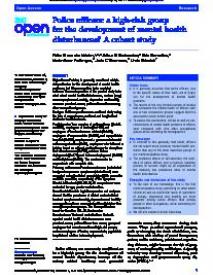Police officers : a high-risk group for the development of mental health disturbances? A cohort study.
Abstract
Objectives Policing is generally considered a high-risk profession for the development of mental health problems, but this assumption lacks empirical evidence. Research question of the present study is to what extent mental health disturbances, such as (very) severe symptoms of anxiety, depression and hostility are more prevalent among police officers than among other occupational groups.
Design Multicomparative cross-sectional study using the data of several cross-sectional and longitudinal studies in the Netherlands.
Participants Two samples of police officers (N=144 and 503), employees of banks (N=1113) and employees of banks who were robbed (N=144); employees of supermarkets (N=335), and a psychiatric hospital (N=219), employees of a governmental social welfare organisation (N=76), employees who followed a training based on rational-motive therapy to strengthen their assertiveness (N=710), soldiers before deployment (N=278) and before redeployment (N=236) and firefighters (N=123). The numbers refer to respondents with complete data.
Primary outcomes Prevalence of severe (subclinical level) and very severe symptoms (clinical level) were computed using the Dutch norm tables (80th percentile and 95th percentile, respectively) of the Symptom Check List Revised (SCL-90-R). All comparisons were controlled for age, gender and education.
Results Multivariate logistic regression and analyses showed that the prevalence of clinical and subclinical levels of symptoms of anxiety, depression and hostility among police officers were not significantly higher than among comparison groups. The same pattern was found for the other SCL-90-R subscales.
Conclusions We found no indications that self-reported mental health disturbances were more prevalent among police officers than among groups of employees that are not considered high-risk groups, such as employees of banks, supermarkets, psychiatric hospital and soldiers before deployment.
In: BMJ open, ISSN 2044-6055 | 3 | 1 | 1-9
http://dx.doi.org/10.1136/bmjopen-2012-001720


